Profile of Phosphatidylserine Modifications under Nitroxidative Stress Conditions Using a Liquid Chromatography-Mass Spectrometry Based Approach
Abstract
1. Introduction
2. Results and Discussion
3. Materials and Methods
3.1. Reagents/Chemicals
3.2. Nitration of Phosphatidylserines
3.3. Phosphorous Measurement-Phospholipid Quantification
3.4. Mass Spectrometry Conditions
3.5. Reverse Phase High-Performance Liquid Chromatography/Tandem Mass Spectrometry
3.6. DPPH● Assay
3.7. ABTS●+ Assay
4. Conclusions
Supplementary Materials
Author Contributions
Funding
Conflicts of Interest
References
- Vance, J.E. Phosphatidylserine and phosphatidylethanolamine in mammalian cells: Two metabolically related aminophospholipids. J. Lipid Res. 2008, 49, 1377–1387. [Google Scholar] [CrossRef] [PubMed]
- Yeung, T.; Gilbert, G.E.; Shi, J.; Silvius, J.; Kapus, A.; Grinstein, S. Membrane Phosphatidylserine Regulates Surface Charge and Protein Localization. Science 2008, 319, 210–213. [Google Scholar] [CrossRef] [PubMed]
- Vance, J.E.; Tasseva, G. Formation and function of phosphatidylserine and phosphatidylethanolamine in mammalian cells. Biochim. Biophys Acta. BBA-Mol. Cell Biol. Lipids 2013, 1831, 543–554. [Google Scholar] [CrossRef] [PubMed]
- Leventis, P.A.; Grinstein, S. The Distribution and Function of Phosphatidylserine in Cellular Membranes. Annu. Rev. Biophys 2010, 39, 407–427. [Google Scholar] [CrossRef] [PubMed]
- Balasubramanian, K.; Mirnikjoo, B.; Schroit, A.J. Regulated Externalization of Phosphatidylserine at the Cell Surface: Implications for Apoptosis. J. Biol. Chem. 2007, 282, 18357–18564. [Google Scholar] [CrossRef] [PubMed]
- Maciel, E.; Silva, R.N.; Simões, C.; Domingues, P.; Domingues, M.R.M. Structural Characterization of Oxidized Glycerophosphatidylserine: Evidence of Polar Head Oxidation. J. Am. Soc. Mass Spectrom. 2011, 22, 1804–1814. [Google Scholar] [CrossRef] [PubMed]
- Maciel, E.; Neves, B.M.; Santinha, D.; Reis, A.; Domingues, P. Detection of phosphatidylserine with a modified polar head group in human keratinocytes exposed to the radical generator AAPH. Arch. Biochem. Biophys. 2014, 548, 38–45. [Google Scholar] [CrossRef] [PubMed]
- Maciel, E.; Faria, R.; Santinha, D.; Domingues, M.R.M.; Domingues, P. Evaluation of oxidation and glyco-oxidation of 1-palmitoyl-2-arachidonoyl-phosphatidylserine by LC–MS/MS. J. Chromatogr. B 2013, 929, 76–83. [Google Scholar] [CrossRef]
- Melo, T.; Videira, R.A.; André, S.; Maciel, E.; Francisco, C.S.; Domingues, M.R.M. Tacrine and its analogues impair mitochondrial function and bioenergetics: A lipidomic analysis in rat brain: Effects on non-synaptic brain mitochondria. J. Neurochem. 2012, 120, 998–1013. [Google Scholar] [CrossRef]
- Matsura, T. Oxidized Phosphatidylserine: Production and Bioactivities. Yonago Acta Med. 2014, 57, 119–127. [Google Scholar]
- Silva, R.N.; Silva, A.C.; Maciel, E.; Simões, C. Evaluation of the capacity of oxidized phosphatidylserines to induce the expression of cytokines in monocytes and dendritic cells. Arch. Biochem. Biophys. 2012, 525, 9–15. [Google Scholar] [CrossRef] [PubMed]
- Milic, I.; Griesser, E.; Vemula, V.; Ieda, N.; Nakagawa, H.; Miyata, N. Profiling and relative quantification of multiply nitrated and oxidized fatty acids. Anal. Bioanal. Chem. 2015, 407, 5587–5602. [Google Scholar] [CrossRef] [PubMed]
- Schoeman, J.C.; Harms, A.C.; Weeghel, M.; Berger, R.; Vreeken, R.J.; Hankemeier, T. Development and application of a UHPLC–MS/MS metabolomics based comprehensive systemic and tissue-specific screening method for inflammatory, oxidative and nitrosative stress. Anal. Bioanal. Chem. 2018, 410, 2551–2568. [Google Scholar] [CrossRef] [PubMed]
- Tsikas, D.; Zoerner, A.A.; Mitschke, A.; Gutzki, F.M. Nitro-fatty Acids Occur in Human Plasma in the Picomolar Range: A Targeted Nitro-lipidomics GC–MS/MS Study. Lipids 2009, 44, 855–865. [Google Scholar] [CrossRef] [PubMed]
- Melo, T.; Domingues, P.; Ferreira, R.; Milic, I.; Fedorova, M.; Santos, S.M.; Domingues, M.R.M. Recent Advances on Mass Spectrometry Analysis of Nitrated Phospholipids. Anal. Chem. 2016, 88, 2622–2629. [Google Scholar] [CrossRef] [PubMed]
- Melo, T.; Domingues, P.; Ribeiro, R.T.M.; Girão, H.; Segundo, M.A.; Domingues, M.R.M. Characterization of phospholipid nitroxidation by LC-MS in biomimetic models and in H9c2 Myoblast using a lipidomic approach. Free Radi.c Biol. Med. 2017, 106, 219–227. [Google Scholar] [CrossRef] [PubMed]
- Melo, T.; Marques, S.S.; Ferreira, I.; Cruz, M.T.; Domingues, P.; Domingues, M.R.M. New Insights into the Anti-Inflammatory and Antioxidant Properties of Nitrated Phospholipids. Lipids 2018, 53, 117–131. [Google Scholar] [CrossRef]
- Santinha, D.R.; Luísa, D.M.; Neves, B.M.; Maciel, E.; Martins, J.; Helguero, L. Prospective phospholipid markers for skin sensitization prediction in keratinocytes: A phospholipidomic approach. Arch. Biochem. Biophys. 2013, 533, 33–41. [Google Scholar] [CrossRef]
- Tyurina, Y.Y.; Tyurin, V.A.; Kapralova, V.I.; Wasserloos, K.; Mosher, M. Oxidative Lipidomics of γ-Radiation-Induced Lung Injury: Mass Spectrometric Characterization of Cardiolipin and Phosphatidylserine Peroxidation. Radiat. Res. 2011, 175, 610–621. [Google Scholar] [CrossRef]
- Tsikas, D.; Zoerner, A.A.; Jordan, J. Oxidized and nitrated oleic acid in biological systems: Analysis by GC–MS/MS and LC–MS/MS, and biological significance. Biochim. Biophys Acta. BBA-Mol. Cell Biol. Lipids 2011, 1811, 694–705. [Google Scholar] [CrossRef]
- Kühn, B.; Brat, C.; Fettel, J.; Hellmuth, N.; Maucher, I.V.; Bulut, U. Anti-inflammatory nitro-fatty acids suppress tumor growth by triggering mitochondrial dysfunction and activation of the intrinsic apoptotic pathway in colorectal cancer cells. Biochem. Pharmacol. 2018, 155, 48–60. [Google Scholar] [CrossRef] [PubMed]
- Reddy, A.T.; Lakshmi, S.P.; Dornadula, S.; Pinni, S.; Rampa, D.R.; Reddy, R.C. The Nitrated Fatty Acid 10-Nitro-Oleate Attenuates Allergic Airway Disease. J. Immunol. 2013, 191, 2053–2063. [Google Scholar] [CrossRef] [PubMed]
- Nie, H.; Xue, X.; Liu, G.; Guan, G.; Liu, H.; Sun, L. Nitro-oleic acid ameliorates oxygen and glucose deprivation/re-oxygenation triggered oxidative stress in renal tubular cells via activation of Nrf2 and suppression of NADPH oxidase. Free Radic. Res. 2016, 50, 1200–1213. [Google Scholar] [CrossRef] [PubMed]
- Chakravartula, S.V.S.; Balazy, M. Characterization of nitro arachidonic acid and nitro linoleic acid by mass spectrometry. Anal. Lett. 2012, 45, 2412–2424. [Google Scholar] [CrossRef]
- Liu, X.; Miller, M.J.S.; Joshi, M.S.; Thomas, D.D.; Lancaster, J.R. Accelerated reaction of nitric oxide with O2 within the hydrophobic interior of biological membranes. Proc. Natl. Acad. Sci. USA 1998, 95, 2175–2179, PMCID: PMC19287. [Google Scholar] [CrossRef] [PubMed]
- Thomas, D.D.; Liu, X.; Kantrow, S.P.; Lancaster, J.R. The biological lifetime of nitric oxide: Implications for the perivascular dynamics of NO and O2. Proc. Natl. Acad. Sci. USA 2001, 98, 355–360. [Google Scholar] [CrossRef] [PubMed]
- Denicola, A.; Batthyány, C.; Lissi, E.; Freeman, B.A.; Rubbo, H.; Radi, R. Diffusion of Nitric Oxide into Low Density Lipoprotein. J. Biol. Chem. 2002, 277, 932–936. [Google Scholar] [CrossRef]
- Lima, E.S.; Di Mascio, P.; Abdalla, D.S. Cholesteryl nitrolinoleate, a nitrated lipid present in human blood plasma and lipoproteins. J. Lipid Res. 2003, 44, 1660–1666. [Google Scholar] [CrossRef]
- Olsen, J.V.; Schwartz, J.C.; Griep-Raming, J.; Nielsen, M.L.; Damoc, E.; Denisov, E. A Dual Pressure Linear Ion Trap Orbitrap Instrument with Very High Sequencing Speed. Mol. Cell Proteom. 2008, 8, 2759–2769. [Google Scholar] [CrossRef]
- Cao, X.; Cai, X.; Mo, W. Comparing the fragmentation reactions of protonated cyclic indolyl α-amino esters in quadrupole/orbitrap and quadrupole time-of-flight mass spectrometers. Rapid Commun. Mass Spectrom. 2018, 32, 543–551. [Google Scholar] [CrossRef]
- Lima, É.S.; Bonini, M.G.; Augusto, O.; Barbeiro, H.V.; Souza, H.P.; Abdalla, D.S.P. Nitrated lipids decompose to nitric oxide and lipid radicals and cause vasorelaxation. Free Radic. Biol. Med. 2005, 39, 532–539. [Google Scholar] [CrossRef] [PubMed]
- Manini, P.; Capelli, L.; Reale, S.; Arzillo, M.; Crescenzi, O.; Napolitano, A. Chemistry of Nitrated Lipids: Remarkable Instability of 9-Nitrolinoleic Acid in Neutral Aqueous Medium and a Novel Nitronitrate Ester Product by Concurrent Autoxidation/Nitric Oxide-Release Pathways. J. Org. Chem. 2008, 73, 7517–7525. [Google Scholar] [CrossRef] [PubMed]
- Lambelet, P.; Saucy, F.; Löliger, J. Radical Exchange Reactions between Vitamin E, Vitamin C and Phospholipids in Autoxidizing Polyunsaturated Lipids. Free Radic Res 1994, 20, 1–10. [Google Scholar] [CrossRef] [PubMed]
- Franz, J.; Bereau, T.; Pannwitt, S.; Anbazhagan, V.; Lehr, A.; Nubbemeyer, U. Nitrated Fatty Acids Modulate the Physical Properties of Model Membranes and the Structure of Transmembrane Proteins. Chem.-Eur. J. 2017, 23, 9690–9697. [Google Scholar] [CrossRef] [PubMed]
- Dacaranhe, C.D.; Terao, J. A unique antioxidant activity of phosphatidylserine on iron-induced lipid peroxidation of phospholipid bilayers. Lipids 2001, 36, 1105–1110. [Google Scholar] [CrossRef] [PubMed]
- Yoshida, K.; Terao, J.; Suzuki, T.; Takama, K. Inhibitory effect of phosphatidylserine on iron-dependent lipid peroxidation. Biochem Biophys Res Commun 1991, 179, 1077–8101. [Google Scholar] [CrossRef]
- Bartlett, E.M.; Lewis, D.H. Spectrophotometric determination of phosphate esters in the presence and absence of orthophosphate. Anal. Biochem. 1970, 36, 159–167. [Google Scholar] [CrossRef]
- Magalhães, L.M.; Segundo, M.A.; Reis, S.; Lima, J.L. Automatic method for determination of total antioxidant capacity using 2,2-diphenyl-1-picrylhydrazyl assay. Anal. Chim. Acta 2006, 558, 310–318. [Google Scholar] [CrossRef]
- Magalhães, L.M.; Barreiros, L.; Maia, M.A.; Reis, S.; Segundo, M.A. Rapid assessment of endpoint antioxidant capacity of red wines through microchemical methods using a kinetic matching approach. Talanta 2012, 97, 473–483. [Google Scholar] [CrossRef]
Sample Availability: Samples of the compounds are not available from the authors. |
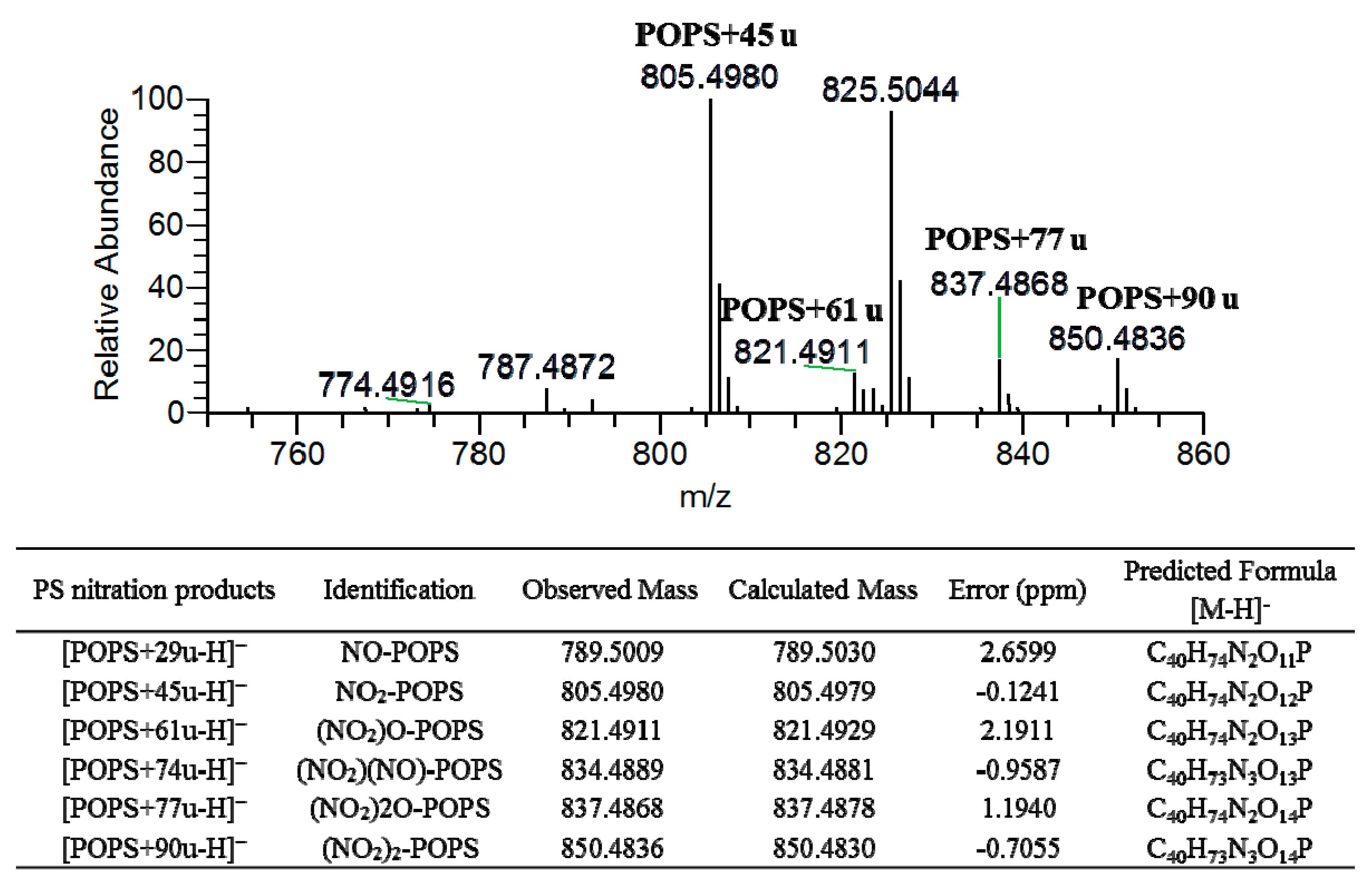
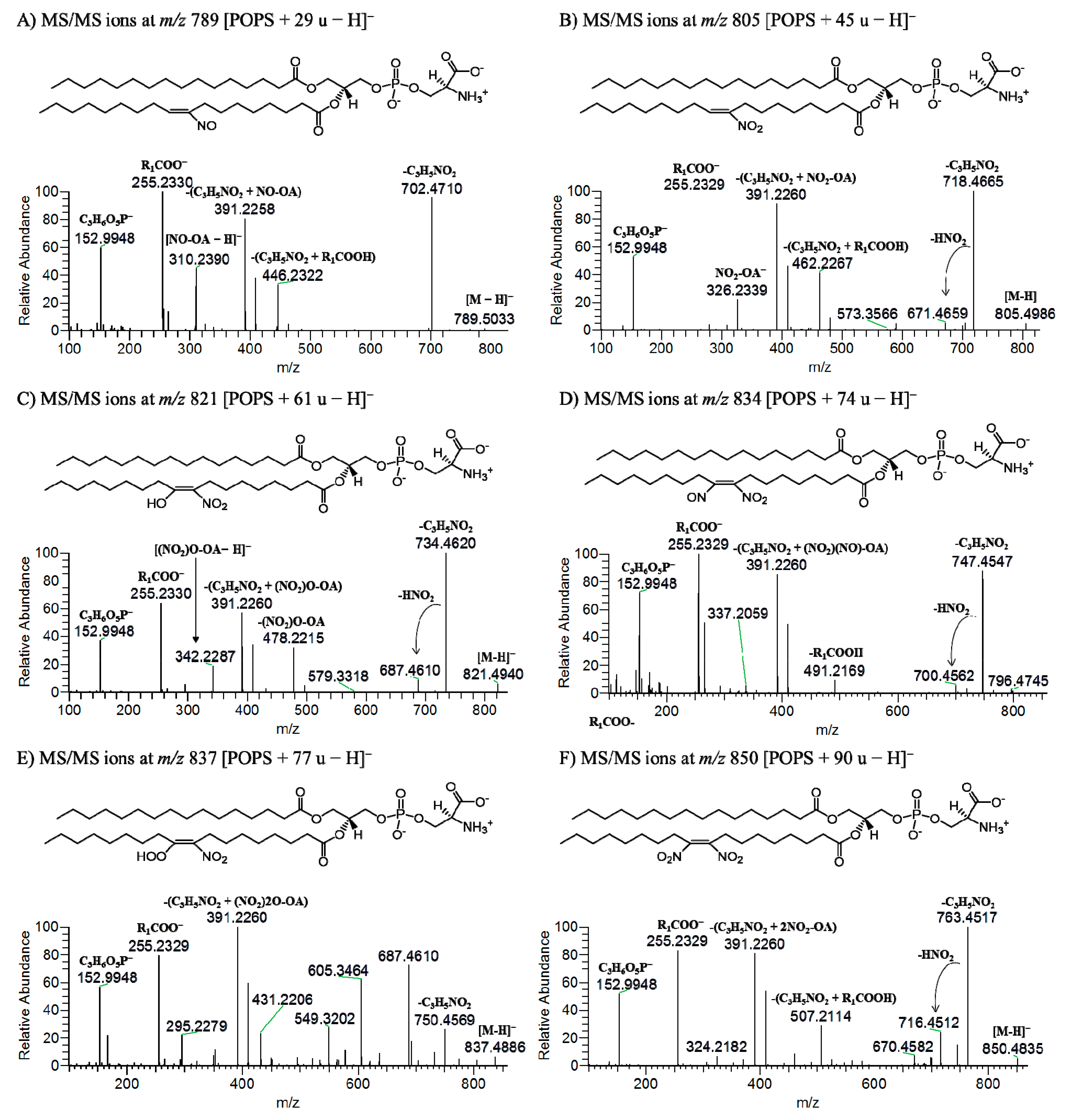
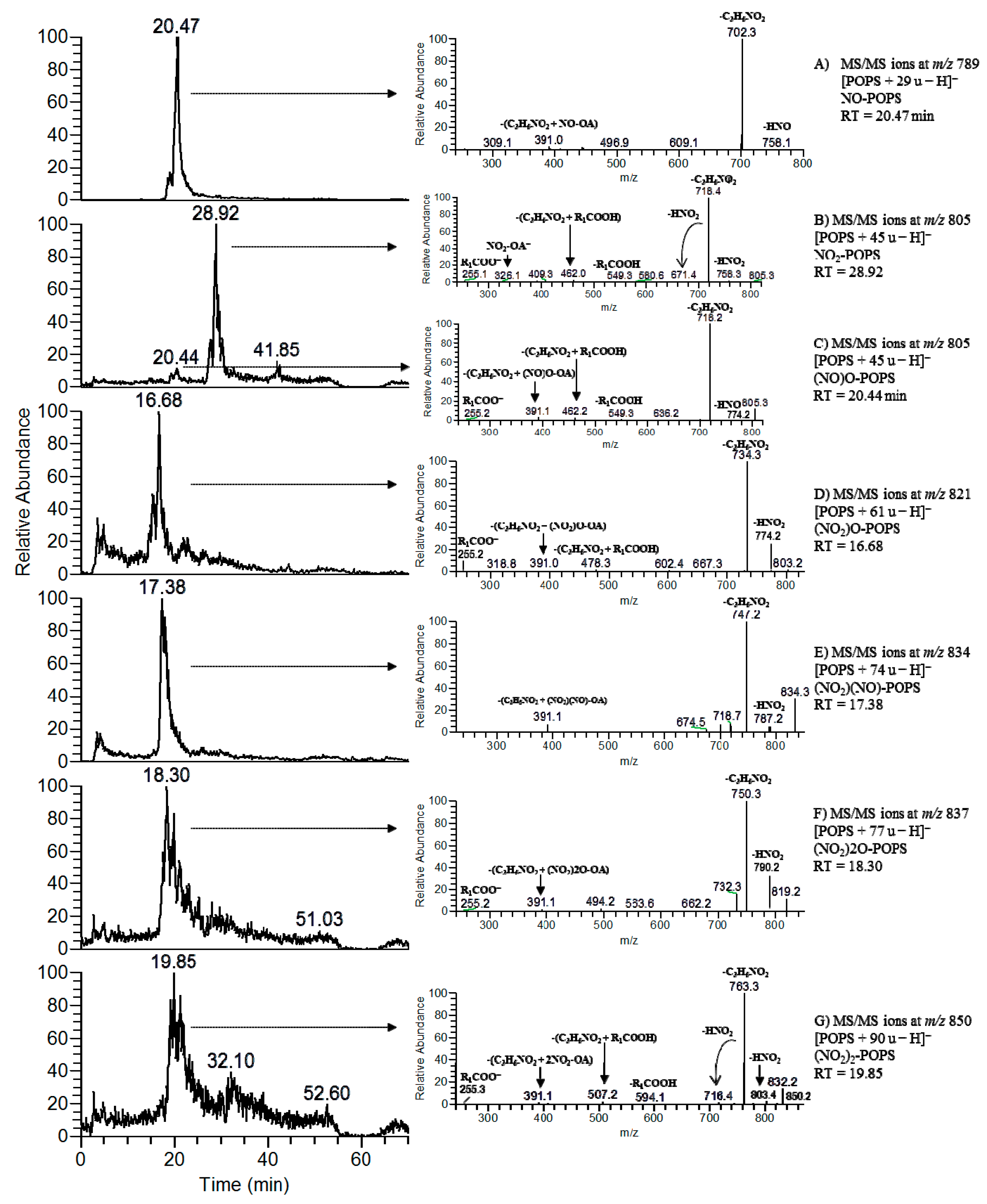
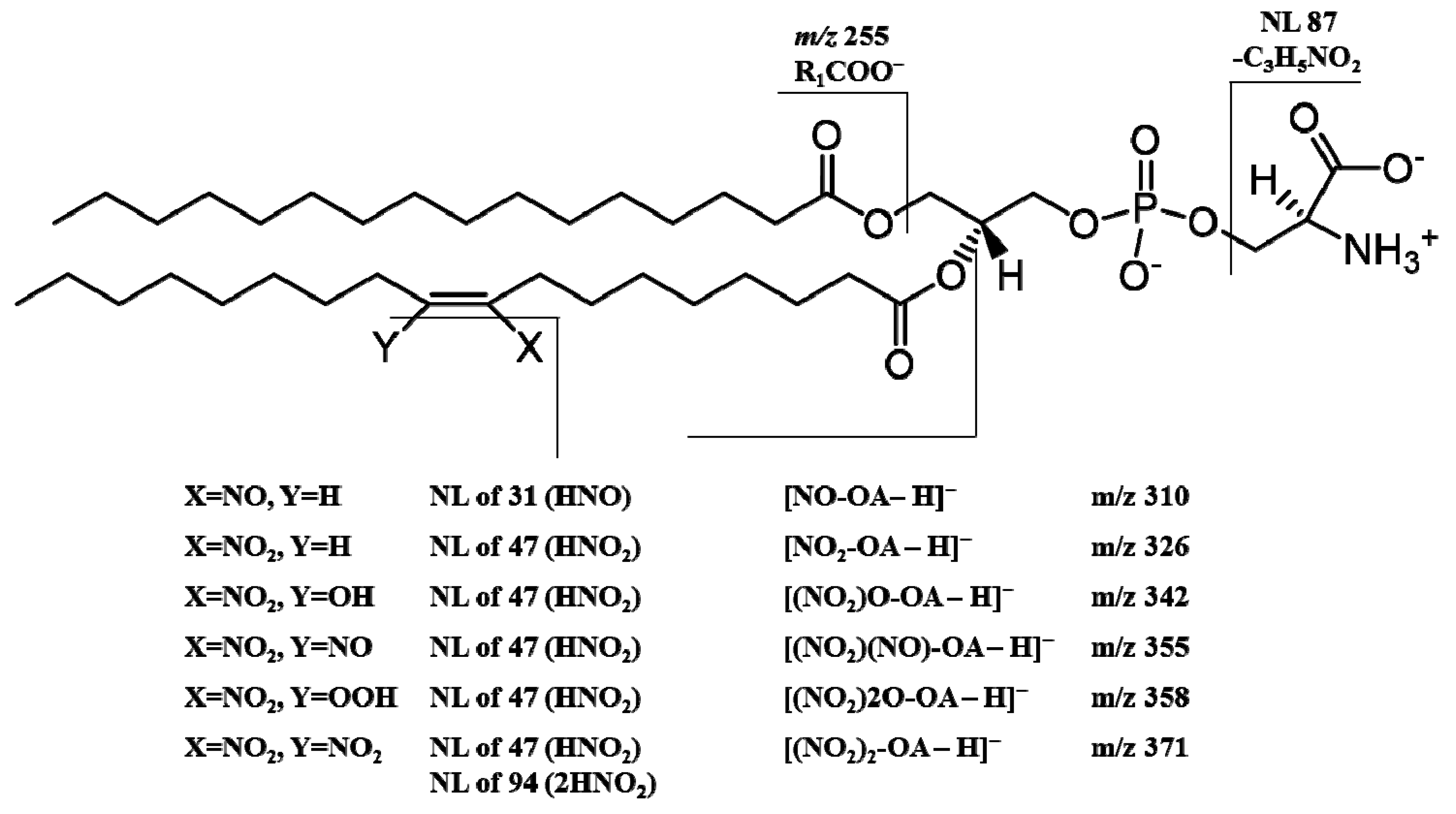
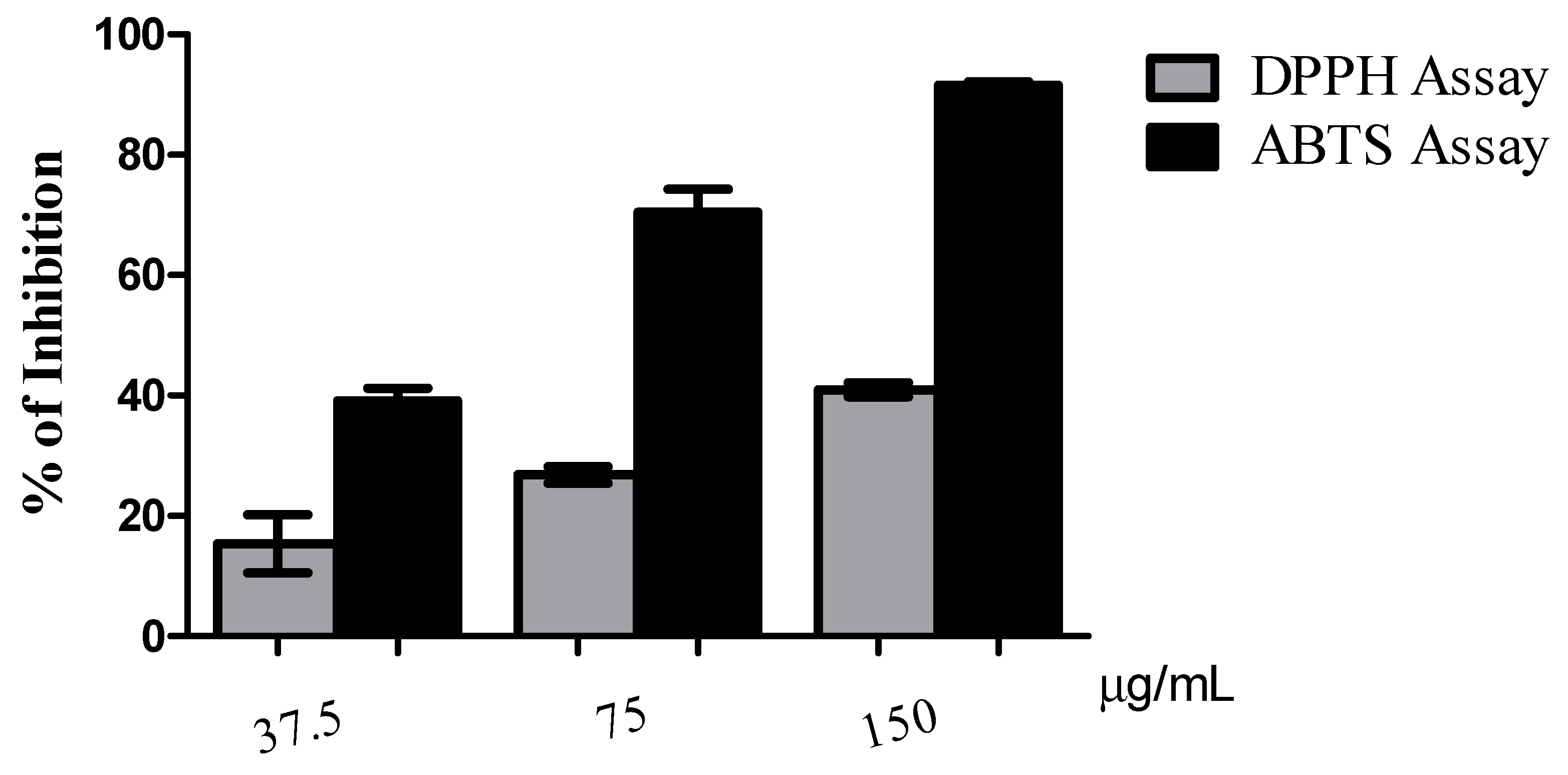
| Neutral Losses | Proposed Precursor Ion Identification | Calculated m/z | Observed m/z | Error (ppm) | Formula |
|---|---|---|---|---|---|
| Precursor ion | [POPS + 29 u − H]− | 789.5030 | 789.5033 | 0.3800 | C40H74N2O11P |
| NO-POPS | |||||
| Product ions | |||||
| 87 u | -C3H5NO2 | 702.4701 | 702.4710 | 1.2812 | C37H69NO9P |
| -- | [NO-OA − H]− | 310.2382 | 310.2390 | 2.5787 | C18H32NO3 |
| -- | [(NO-OA) − HNO − H]− | 279.2324 | 279.2332 | 2.8650 | C18H31O2 |
| -- | R1COO− | 255.2324 | 255.2330 | 2.3508 | C16H31O2 |
| -- | C3H6O5P− | 152.9953 | 152.9948 | −3.2681 | C3H6O5P |
| Precursor ion | [POPS + 45 u − H]− | 805.4979 | 805.4986 | 0.8690 | C40H74N2O12P |
| NO2-POPS | |||||
| Product ions | |||||
| 47 u | -HNO2 | 758.4972 | 758.4982 | 1.3184 | C40H73NO10P |
| 87 u | -C3H5NO2 | 718.4659 | 718.4665 | 0.8351 | C37H69NO10P |
| 134 u (47 + 87) | -(C3H5NO2 + HNO2) | 671.4652 | 671.4659 | 1.0425 | C37H68O8P |
| -- | [NO2-OA − H]− | 326.2331 | 326.2339 | 2.3480 | C18H32NO4 |
| -- | [(NO2-OA) − HNO2 − H]− | 279.2324 | 279.2330 | 2.1487 | C18H31O2 |
| -- | R1COO− | 255.2324 | 255.2329 | 1.9590 | C16H31O2 |
| -- | C3H6O5P− | 152.9953 | 152.9948 | −3.2681 | C3H6O5P |
| Precursor ion | [POPS + 61 u − H]− | 821.4929 | 821.4940 | 1.3390 | C40H74N2O13P |
| (NO2)O-POPS | |||||
| Product ions | |||||
| 47 u | -HNO2 | 774.4921 | 774.4928 | 0.9038 | C40H73NO11P |
| 87 u | -C3H5NO2 | 734.4608 | 734.4620 | 1.6339 | C37H69NO11P |
| 134 u (47 + 87) | -(C3H5NO2 + HNO2) | 687.4601 | 687.4610 | 1.3092 | C37H68O9P |
| -- | [(NO2)O-OA − H]− | 342.2281 | 342.2287 | 1.7532 | C18H32NO5 |
| -- | [(NO2)O-OA) − HNO2 − H]− | 295.2273 | 295.2279 | 2.0323 | C18H31O3 |
| -- | R1COO− | 255.2324 | 255.2330 | 2.3508 | C16H31O2 |
| -- | C3H6O5P− | 152.9953 | 152.9948 | -3.2681 | C3H6O5P |
| Precursor ion | [POPS + 74 u − H]− | 834.4881 | 834.4883 | 0.2397 | C40H73N3O13P |
| (NO2)(NO)-POPS | |||||
| Product ions | |||||
| 87 u | -C3H5NO2 | 747.4561 | 747.4547 | −1.8730 | C37H68N2O11P |
| 134 u (47 + 87) | -(C3H5NO2 + HNO2) | 700.4553 | 700.4562 | 1.2849 | C37H67NO9P |
| -- | [(NO2)(NO)-OA − H]− | 355.2233 | 355.2255 | 6.1933 | C18H31N2O5 |
| -- | [(NO2)(NO)-OA) − HNO2 − H]− | 308.2226 | 308.2234 | 2.5955 | C18H30NO3 |
| -- | R1COO− | 255.2324 | 255.2329 | 1.9590 | C16H31O2 |
| -- | C3H6O5P− | 152.9953 | 152.9948 | −3.2681 | C3H6O5P |
| Precursor ion | [POPS + 77 u – H]− | 837.4878 | 837.4866 | −1.4329 | C40H74N2O14P |
| (NO2)2O-POPS | |||||
| Product ions | |||||
| 47 u | -HNO2 | 790.4870 | 790.4866 | −0.5060 | C40H73NO12P |
| 87 u | -C3H5NO2 | 750.4557 | 750.4569 | 1.5990 | C37H69NO12P |
| 134 u (47 + 87) | -(C3H5NO2 + HNO2) | 703.4550 | 703.4548 | −0.2843 | C37H68O10P |
| -- | [(NO2)2O-OA − H]− | 358.2230 | 358.2239 | 2.6129 | C18H32NO6 |
| -- | [(NO2)2O-OA) − O2 − H]− | 326.2331 | 326.2338 | 2.1457 | C18H32NO4 |
| -- | [(NO2)2O-OA) − HNO2 − H]− | 311.2222 | 311.2230 | 2.5705 | C18H31O4 |
| -- | R1COO− | 255.2324 | 255.2329 | 1.9590 | C16H31O2 |
| -- | C3H6O5P− | 152.9953 | 152.9948 | −3.2681 | C3H6O5P |
| Precursor ion | [POPS + 90 u − H]− | 850.4830 | 850.4835 | 0.5879 | C40H73N3O14P |
| (NO2)2-POPS | |||||
| Product ions | |||||
| 47 u | -HNO2 | 803.4823 | 803.4825 | 0.2489 | C40H72N2O12P |
| 87 u | -C3H5NO2 | 763.4510 | 763.4517 | 0.9300 | C37H68N2O12P |
| 134 u (47 + 87) | -(C3H5NO2 + HNO2) | 716.4503 | 716.4513 | 1.3958 | C37H67NO10P |
| 181 u (94 + 87) | -(C3H5NO2 + 2HNO2) | 669.4495 | 669.4505 | 1.4938 | C37H66O8P |
| -- | [(NO2)2-OA − H]− | 371.2182 | 371.2191 | 2.4245 | C18H31N2O6 |
| -- | [((NO2)2-OA) − HNO2 − H]− | 324.2175 | 324.2182 | 2.1590 | C18H30NO4 |
| -- | [((NO2)2-OA) − 2HNO2 2013 H]− | 277.2168 | 277.2174 | 2.1644 | C18H29O2 |
| -- | R1COO− | 255.2324 | 255.2329 | 1.9590 | C16H31O2 |
| -- | C3H6O5P− | 152.9953 | 152.9948 | −3.2681 | C3H6O5P |
| Mass Shift to Unmodified PS | Typical Neutral Losses in MS/MS | ||
|---|---|---|---|
| Nitrated Derivatives | |||
| NO-PS | Nitroso | +29 u | −31 u (HNO) |
| NO2-PS | Nitro | +45 u | −47 u (HNO2) |
| (NO2)(NO)-PS | Nitronitroso | +74 u | −31 u (HNO); −47 u (HNO2) |
| (NO2)2-PS | Dinitro | +90 u | −47 u (HNO2); −94 u (2HNO2) |
| Nitroxidized Derivatives | |||
| (NO)O-PS | Nitrosohydroxy | +45 u | −31 u (HNO) |
| (NO2)O-PS | Nitrohydroxy | +61 u | −47 u (HNO2) |
| (NO2)2O-PS | Nitrohydroperoxy | +77 u | −47 u (HNO2); −32 u (O2) |
| Product Ions | Typical Modified Carboxylate Anions in MS/MS | ||
| [NO-OA − H]− | NO-PS | m/z 310.2 | |
| [(NO-OA) − HNO − H]− | m/z 279.2 | ||
| [NO2-OA − H]− | NO2-PS | m/z 326.2 | |
| [(NO2-OA) − HNO2 − H]− | m/z 279.2 | ||
| [(NO2)O-OA − H]− | (NO2)O-PS | m/z 342.2 | |
| [(NO2)O-OA) − HNO2 − H]− | m/z 295.2 | ||
| [(NO2)(NO)-OA − H]− | (NO2)(NO)-PS | m/z 355.2 | |
| [(NO2)(NO)-OA) − HNO2 − H]− | m/z 308.2 | ||
| [(NO2)2O-OA − H]− | (NO2)2O-PS | m/z 358.2 | |
| [((NO2)2O-OA) − O2 − H]− | m/z 326.2 | ||
| [((NO2)2O-OA) − HNO2 − H]− | m/z 311.2 | ||
| [(NO2)2-OA − H]− | (NO2)2-PS | m/z 371.2 | |
| [((NO2)2-OA) − HNO2 − H]− | m/z 324.2 | ||
| [((NO2)2-OA) − 2HNO2 − H]− | m/z 277.2 | ||
© 2018 by the authors. Licensee MDPI, Basel, Switzerland. This article is an open access article distributed under the terms and conditions of the Creative Commons Attribution (CC BY) license (http://creativecommons.org/licenses/by/4.0/).
Share and Cite
Neves, B.; Domingues, P.; Oliveira, M.M.; Domingues, M.d.R.; Melo, T. Profile of Phosphatidylserine Modifications under Nitroxidative Stress Conditions Using a Liquid Chromatography-Mass Spectrometry Based Approach. Molecules 2019, 24, 107. https://doi.org/10.3390/molecules24010107
Neves B, Domingues P, Oliveira MM, Domingues MdR, Melo T. Profile of Phosphatidylserine Modifications under Nitroxidative Stress Conditions Using a Liquid Chromatography-Mass Spectrometry Based Approach. Molecules. 2019; 24(1):107. https://doi.org/10.3390/molecules24010107
Chicago/Turabian StyleNeves, Bruna, Pedro Domingues, Maria Manuel Oliveira, Maria do Rosário Domingues, and Tânia Melo. 2019. "Profile of Phosphatidylserine Modifications under Nitroxidative Stress Conditions Using a Liquid Chromatography-Mass Spectrometry Based Approach" Molecules 24, no. 1: 107. https://doi.org/10.3390/molecules24010107
APA StyleNeves, B., Domingues, P., Oliveira, M. M., Domingues, M. d. R., & Melo, T. (2019). Profile of Phosphatidylserine Modifications under Nitroxidative Stress Conditions Using a Liquid Chromatography-Mass Spectrometry Based Approach. Molecules, 24(1), 107. https://doi.org/10.3390/molecules24010107





